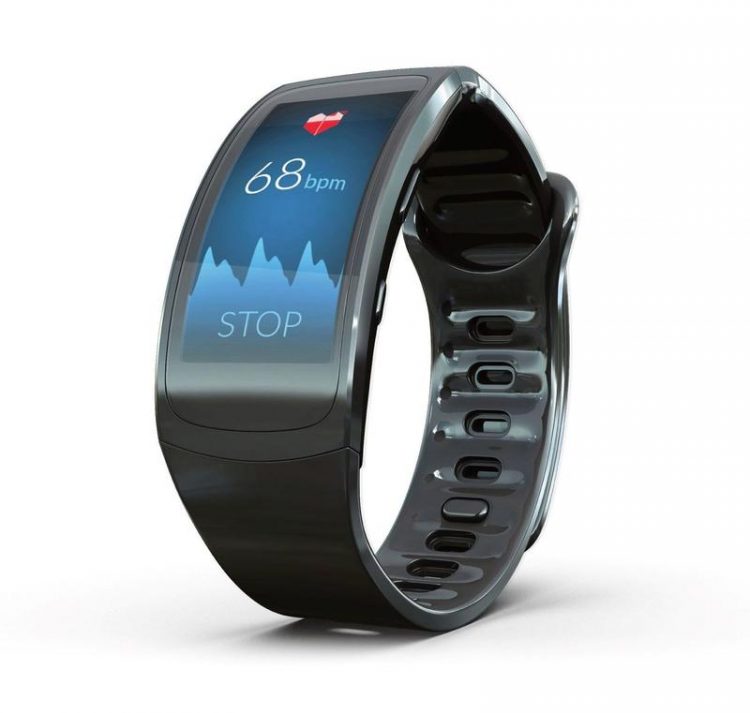Faster detection of atrial fibrillation thanks to smartwatch

A smartwatch using an app which can record heart rhythm to detect atrial fibrillation. Source: PREVENTICUS GmbH, Jena
Atrial fibrillation is the most common cardiac arrhythmia. Experts expect that it will occur even twice as often in the over 55's in the next 40 years. If the heart gets our of rhythm, the risk of stroke increases.
However, the use of anti-coagulants can reduce this risk by up to 70 percent. The problem with this is, that atrial fibrillation frequently goes undetected and thus untreated, because it often occurs intermittently and doesn't cause any symptoms.
It is known that atrial fibrillation can be more frequently detected in a timely manner through increased and extended screenings of the cardiac rhythm.
Professor Marcus Dörr from the University Medicne Greifswald and his Swiss colleagues from the Basel University Hospital were able to show that smartwatches offer a good option to comfortably and relatively easily monitor the heart rhythm.
In a prospective controlled study, they examined 508 people with and without atrial fibrillation to see whether a smartwatch with an app to record the heart rhythm can accurately detect atrial fibrillation. For this purpose, the recordings from the smartwatches were analysed using an automated algorithm with regard to the presence of atrial fibrillation.
The results were compared to a mobile electrocardiogram (ECG) device, in which two fingers from the right and left hands are laid on an electrode for measurement. These ECGs were subsequently evaluated by cardiologists who had no further information about the participants.
The trial showed that the smartwatch could detect atrial fibrillation at least as well and as accurately as the mobile ECG. “It was particularly important that not too many false positive results were found by the app. “So atrial fibrillation was displayed, if in fact there was none”, says Dörr. “Because this would result in unnecessary examinations and costs.”
Signal interference through movement
However, there were problems with the quality of the signal. Usually these disruptions occurred when the wearer were moving. Then the smartwatch could not always correctly capture the heart rhythm. In the study, the researchers were not able to analyse 20 percent of the data due to poor signal quality.
“A possible solution could be having multiple automated recordings of the heart rhythm at night, when wearers move less frequently, in addition to the improvement of the algorithm”, says DZHK investigator Dörr. The study also showed that a repeated one-minute recording suffices to reliably detect cardiac arrhythmias. Also, an extended recording interval of three or five minutes did not produce better results.
Smartwatch could fill diagnostic gap
However, before the smartwatch can actually be used for screening of high-risk patients, further clinical trials are required. An EU-financed study is already underway, to investigate whether a smartwatch can reliably detect asymptomatic atrial fibrillation in higher risk patients.
Currently, patients with an increased risk of atrial fibrillation undergo a long-term ECG, which records the heart rhythm for up to 72 hours. If no abnormalities are detected during this period, one can theoretically stop monitoring the heart rhythm, according to the medical guidelines. If the risk is very high, small implantable event recorders behind the sternum can be surgically implanted in selected cases.
An expensive and invasive method. Other external devices for rhythm monitoring are expensive and often not reimbursed by health insurance. A smartwatch is comparably inexpensive and can be purchased by everyone, in theory. It may therefore close the gap between the long-term ECG and an implanted devices in the future.
Contact: Professor Marcus Dörr, Department of Internal Medicine B, University Medicine Greifswald & German Centre for Cardiovascular Research, partner site Greifswald, mdoerr(at)uni-greifwald.de
Original work: The WATCH AF Trial: SmartWATCHes for Detection of Atrial Fibrillation.
Dörr M, Nohturfft V, Brasier N, Bosshard E, Djurdjevic A, Gross S, Raichle CJ, Rhinisperger M, Stöckli R, Eckstein J. JACC Clin Electrophysiol. 2019 Feb;5(2): 199-208. Epub 2018 Nov 28. DOI:10.1016/j.jacep.2018.10.006.
https://dzhk.de/aktuelles/news/artikel/vorhofflimmern-rechtzeitig-erkennen-dank-…
Media Contact
All latest news from the category: Medical Engineering
The development of medical equipment, products and technical procedures is characterized by high research and development costs in a variety of fields related to the study of human medicine.
innovations-report provides informative and stimulating reports and articles on topics ranging from imaging processes, cell and tissue techniques, optical techniques, implants, orthopedic aids, clinical and medical office equipment, dialysis systems and x-ray/radiation monitoring devices to endoscopy, ultrasound, surgical techniques, and dental materials.
Newest articles

Innovative 3D printed scaffolds offer new hope for bone healing
Researchers at the Institute for Bioengineering of Catalonia have developed novel 3D printed PLA-CaP scaffolds that promote blood vessel formation, ensuring better healing and regeneration of bone tissue. Bone is…

The surprising role of gut infection in Alzheimer’s disease
ASU- and Banner Alzheimer’s Institute-led study implicates link between a common virus and the disease, which travels from the gut to the brain and may be a target for antiviral…

Molecular gardening: New enzymes discovered for protein modification pruning
How deubiquitinases USP53 and USP54 cleave long polyubiquitin chains and how the former is linked to liver disease in children. Deubiquitinases (DUBs) are enzymes used by cells to trim protein…



